Within the scope of this book, the simplest and most direct way to affect and benefit most of the glands involves one technique, paidagong tapping and patting; not much explanation will be necessary. The few exceptions are included in the descriptions that follow. Glandular health is very important, and it is seldom (if ever) addressed in more conventional exercise and self-care systems.
Glandular secretions affect every aspect of human functioning through all stages of life from birth to death. If we additionally understand glandular secretions to be Jing essences, we can extend that to say that we are influenced by them from the moment of conception, and perhaps even earlier than that. The range of influence includes growth, development, cellular repair and regeneration (and by extension, how quickly and how well we age), sexuality and procreation, immune support, metabolism, energy production, nutrient utilization, emotional balance, mental perception, everything that is hormonally regulated, and many things that have no obvious hormonal correlation. Consequently, maintaining glandular health is of utmost importance.
The pineal gland is about the size of a pea. It’s located near the center of the brain, between the two brain hemispheres. It converts nerve signals from the sympathetic system into hormone signals, establishing a connection between the endocrine and nervous systems. Among other things, it secretes melatonin, which regulates sleep/wake cycles and plays a role in sexual development. Readers with a spiritual or metaphysical orientation know that it is associated with the upper Dantian from a Chinese perspective, or the sixth chakra in Indian spiritual philosophy. Its awakening is linked to spiritual development and increased psychic awareness and ability.
Using either or both the index and middle fingers singly, simultaneously, or alternating, tap the region directly between your eyebrows, at the point colloquially referred to as the third eye. Although the pineal gland is near the center of the brain, there is an energy pathway that connects directly to it from the external third eye, which is exactly why it’s a popular point of focus in many meditation practices. You may feel a bony indentation there, or you may not. The tapping should be gentle and even, and it should produce a pleasant sensation, almost like a very mild tickle.
Tap for just a minute or two. There is no set number of taps. Remember that you want to make incremental improvement over time. Trying to do it all at once by tapping for a long time will not work, and will in fact be counterproductive. Whether or not one does energy practices, this is a region where qi easily gets stuck. One common manifestation of that is a headache in that location. Overthinking, worry, and overuse of the eyes, as well as energy practices that bring energy up the body but incompletely circulate it back down (either by design or by practitioner error or inexperience) are just a few things that can cause qi to get stuck there.
2. Pituitary and Hypothalamus Tap
The pituitary gland is located at the base of the brain between the optic nerves, in front of the spinal cord. This small endocrine organ is often called the “Master Gland” because it directs other endocrine glands, to suppress or induce their hormone production. One of its most well-known hormone secretions, human growth hormone (HGH), is involved with cellular growth and repair, as well as regulating the activity of other glands, and is thought by many to be our internal “fountain of youth.” High circulating levels of HGH halts and may even reverse many of the signs of aging. The pituitary also acts on the muscles and kidneys, and stores some of the hormones produced by the hypothalamus.
The hypothalamus lies just below the thalamus (a relay center for sensory and motor pathways in the brain), deeply buried in the brain, near the center of the cranial cavity. It has a special structural and functional relationship with the pituitary gland, which dangles below it, attached by a thin stalk of nerve fibers and blood vessel connections.
It is the control center for many autonomic functions of the peripheral nervous system. Connections with structures of the endocrine and nervous systems enable the hypothalamus to play a vital role in maintaining homeostasis, regulating body temperature, blood pressure, and heart rate. It influences ovarian and testicular function, mood and behavior, sleep cycles, energy levels, and general metabolism. Sometimes called “the brain of the brain,” almost everything the hypothalamus does relates to the management of brain and body connection, linking the mind to the body. Because of their very close anatomical location and some functional interdependence, this exercise addresses the pituitary and hypothalamus at the same time.
The easiest way to do this tap is to take more of a “ray gun” approach, sending a relatively large wave through the head. There are more narrow, focused methods, but this way is very effective and anyone can do it. Make loose, soft fists with each hand, and at the back of the head, tap the base of the skull, just below the bone and close to either side of the neck vertebrae. You can use either the knuckle side of the four fingers at the front of each hand (Fig 9.1 on next page), or for a slightly more directed focus, the little finger side of each fist (Fig 9.2 on next page). You can hold your head completely upright, or incline it slightly forward if that gives you easier access to the base of your skull. Alternate hand taps rapidly, and direct the force of your right hand toward your left eye, and your left hand toward your right eye. That will ensure that the wave travels through both the pituitary gland and the hypothalamus. You may also feel a more diffuse wave traveling through most or all of the rest of your head. That’s normal and provides some secondary benefit. An additional secondary benefit is this will soften and relax the tight neck muscles that most people have at the juncture of the head and back of the neck.
Tap for just a minute or two. There is no set number of taps. Remember that you want to make incremental improvement over time. Trying to do it all at once by tapping for a long time will not work, and will in fact be counterproductive.
The thyroid is a butterfly-shaped gland that sits low on the front of the neck, below your Adam’s apple, along the front of the windpipe. It secretes several thyroid hormones. Thyroid hormones act throughout the body, influencing metabolism, growth and development, and body temperature. It is crucial for brain development in infancy and childhood; in adults it facilitates the functioning of the nervous, cardiovascular, and gastrointestinal systems. This massage will additionally benefit the parathyroid glands, four pea-sized bodies located behind the thyroid gland. They increase calcium levels in the blood, helping to maintain bone quality and an adequate supply of calcium needed for muscle movement and signal transmission within the cells.
Energetically, there are a number of acupoints along the front of the neck, on the Stomach and Large Intestine meridians. With its paired Yin organ, the Spleen, the Stomach influences gastrointestinal and muscle function. The Large Intestine’s paired Yin organ is the Lungs. Lungs and Spleen are involved in metabolism, notably in the areas of energy production. This dovetails with comparable thyroid functions. The base of the throat is also the seat of the fifth chakra, which has to do with communication, self-expression, and creativity as it relates to communicating self-expression. Honest communication and self-expression are often discouraged and suppressed in our culture, in the workplace and even at home, so the throat is another area where qi will frequently become stuck.
Since the front of the neck is more sensitive and less well protected by thick muscle or bone, this exercise is not a paidagong, but a type of massage done in three stages. For the purpose of this exercise, the designations of “right hand, left hand” are arbitrary, and you can reverse them if you are more comfortable doing so.
Place the thumb and index finger of your left hand at the base of your throat, directly on your collarbone, to the outside of the bony bumps you will feel there. Gripping the base of your neck and collarbones lightly, exert some downward pressure on your collarbones. Place your right hand directly over your left, right thumb over left index finger, right index finger over left thumb. Gently but firmly grasp the sides of your throat, and slide your right hand up, stretching your throat until your fingers reach the inside of your jawbone (Fig 9.3 on next page). You will feel the sides of the base of your tongue there. Push gently upward for a couple of seconds. Repeat this stretch and lift your throat two more times.
After the third repetition, keep your right hand just below your jaw, and remove your left hand to begin the second part of this exercise. Now you can add the middle and ring fingers of your right hand to get a better grip on your throat. Starting just below your jaw, move your throat side to side, just enough so you can clearly feel it move back and forth a few times. You should not feel any pain, and you should not feel like you are choking yourself. Then move your hand downward a bit, and repeat. Depending on the size of your hand and length of your neck, you may be able to divide your throat into three, four, or five regions as you move it side to side one region at a time. You might feel or hear small crunching sounds as bound tissue is released. You may feel a slight tickle in your throat prompting you to cough. Both of those reactions are normal. One pass down your neck is usually enough, but if you want to do this two or three times, that’s okay too.
The last part of this exercise is direct point massage. Most of these points are not standard acupoints, since needles are directed into the portion of the meridians that are in the muscle and not into the throat itself. Here, you will use your thumb and index finger like a pincer, directing force toward the sides of, and whenever possible just behind, your throat. From the previous two exercises, you will have felt small ridges at the sides of your throat. Starting at the top of your throat, use your thumb and index finger to press into the space between two of those ridges. Use light to moderate pressure only. You only want to make a solid enough contact so that you can physically move the tissue below your fingertips. When you have that contact, make small circling motions with your fingers, ten times in one direction, and then ten times in the opposite direction. Then move your fingers down to the next space you are able to feel between the ridges and repeat. Continue down the neck in this way until you get to the base of your throat.
Caution: In men and women, when you get to the level of the thyroid cartilage, the prominent Adam’s apple in men, there will be more of a bony feeling. In fact there is a bone just above the thyroid cartilage, called the hyoid bone, which is flexible yet delicate, so take care in any bony region you feel. Sometimes tilting your head back slightly will open your neck enough to feel for the depression between ridges there too, but you may need to skip over that region entirely. Do not put direct pressure on any bony protrusion you may encounter.
The thymus is a gland composed of lymphatic tissue, located in the upper central chest, behind the sternum (breastbone), midway between top of the heart and the sternal notch at the base of the throat. It is most active in youth, enlarging until puberty, at which time it begins to shrink. In recent years, it has come to be recognized as still important through adulthood. The thymus forms part of the immune system, transforming lymphocytes (white blood cells that develop in the bone marrow), into T-cells. These cells are then transported to various lymph glands, where they play an important role in fighting infections and disease. The thymus also produces hormones that regulate T-cell maturation. The Thymus Tap stimulates this gland, helping to keep it functionally active throughout later adult years.
Make a soft fist with either hand, and thump your upper chest on your breastbone, below your throat notch and above your heart. Vary the rhythm and speed, and within comfortable limits, even the strength of the thump. The body tends to adapt to any repetitive stimulus, eventually “ignoring” it. Varying the rate, rhythm, and strength makes this unlikely. Do this for just a minute or two each day.
The adrenals are a pair of triangular glands about one to two inches long, that sit on each of the kidneys in the low back. They secrete more than three dozen hormones directly into the bloodstream. The outer region takes its instructions from the pituitary hormone ACTH, and secretes steroid hormones such as cortisone and testosterone, which have important effects on the way energy is stored and utilized, on sexuality, and on many aspects of blood chemistry. The smaller, inner region is part of the sympathetic nervous system and responds to physical and emotional stress. Reacting to fear, anger, or perceived emergency, it produces epinephrine and norepinephrine (adrenaline and noradrenaline), which are sometimes called “fight or flight” hormones.
The kidneys are bean-shaped organs about the size of a fist, located in the lower back on each side of the vertebrae. They filter toxins from the blood and excrete them as urine. They also filter out normal substances from the blood when they are present in greater than normal concentrations, as a means of maintaining homeostasis. The kidney is an endocrine gland itself, secreting the hormones erythropoietin, involved in the formation of red blood cells, and calcitriol, the active form of vitamin D.
The kidneys are commonly damaged by diabetes and high blood pressure, two diseases that are very prevalent in modern cultures. While this exercise won’t repair existing damage, it can help to prevent it from occurring, as well as support kidney and adrenal health overall.
This paidagong can be done standing, but may be more comfortable when practiced sitting, on the floor or on a chair or stool. Make soft fists with both hands, and with either the thumb and index finger sides of the fists (Fig 9.4), or the backs of the fists (Fig 9.5 on next page), tap your low back, from your lowest rib to just above your pelvis. Many people have low back tension, discomfort, or pain, and this tap can be surprisingly soothing. A hundred taps on each kidney will only take about a minute, and is the recommended daily minimum for this practice. You can do this for a few minutes longer if you like. The kidneys are sensitive organs, so while you do want to vary the rate and rhythm of the taps, take care not to tap too hard.
In all aspects of Chinese medicine, it’s standard practice to first dispel any pathogenic influence, and then bring in healthy qi to rebuild, repair, or restore normal function to the affected organ/meridian system(s). The Kidney/Adrenal Tap above disperses stagnant qi, and under most circumstances should be practiced before the Kidney Massage. The Kidney Massage is soothing, nourishing, and warming; settles the qi that was stirred up by the paidagong and gathers healthy qi to tonify and replenish the kidneys.
In Chinese medicine, the kidneys are known to affect health and life in general broadly, with a much more complex array of interrelationships than is understood by Western medicine. To name a few, this includes childhood growth and development, sexual/reproductive health and vitality—the testes are in fact commonly called “the external kidneys”—bone density, tooth health (as an extension of bone health), head hair, longevity/healthy aging, auditory acuity, and memory and concentration, as well as their Western roles in fluid metabolism and the excretion of waste. Maintaining kidney health is one of the primary keys to a long and healthy life.
The Kidney Massage can be done in one of two ways. If possible, it’s best to use the palms of your hands directly on your kidneys. Done this way, first rub your hands together for a minute or two to warm them, bringing more qi and blood there. Next, place your hands on your low back, your right hand over your right kidney, and your left hand over your left kidney (Fig 9.6 on previous page). Massage in small circles for a minute or two in one direction, and then reverse direction for the same amount of time. Do your best to engage the muscles below the skin, so that the muscles move and you’re not just sliding your hands over your skin. Feel for the warmth of your hands penetrating all the way into your kidneys. There is no maximum time limit for this practice, so you can continue it beyond a few minutes if you’d like.
Some people have very tight shoulders and are unable to place their palms directly on their low back. In that case, this method is a good alternative option that should be possible for almost anyone. Make soft fists with your thumbs curled around your fingers. Place the sides of your fists at your low back, so that the web region between thumb and index fingers are touching your back above each kidney. You can make circles in the manner described above, or you can simply move your fists up and down. Again, try to use enough pressure so that you move the back muscles under the skin, and not just the skin itself. With practice over time, you may feel the kidneys move with the movement of your hands.
7. For Men Only—Prostate Massage
There are many Daoist and other Chinese practices designed to enhance sexual performance. This practice is not one of those, but rather is specifically to promote a man’s general and sexual health. Good health is the necessary foundation for better performance in any activity, though, so you may notice some improvements in your sexual performance as your prostate become healthier.
The prostate is a walnut-sized gland located between the bladder and the penis, just in front of the rectum. The urethra runs through the center of the prostate, from the bladder to the penis, letting urine flow out of the body. Along with the adjacent seminal vesicles, the prostate secretes a slightly alkaline fluid that nourishes and protects sperm. During ejaculation, it squeezes this fluid into the urethra, and it’s expelled with sperm as semen. The alkalinity of semen helps neutralize the acidity of the vaginal tract, prolonging the sperm’s lifespan.
While some men may be embarrassed by or psychologically uncomfortable with this exercise, the Prostate Massage is very important for men’s sexual and general health. Regardless of the amount of sexual activity one has, the prostate gland frequently becomes enlarged as men age, congesting with blood, prostatic fluid and other body fluids. This sets the stage for BPH, benign prostatic hyperplasia/hypertrophy, a non-cancerous enlargement of the prostate gland, which can cause discomfort, burning urination, reduced and/or urgent urinary flow, frequent nighttime urination, and an increased possibility of urinary tract infections, among other things. Although there is no definitive Western medical link between BPH and prostate cancer, from a Chinese medical perspective, the factors that cause BPH and the secondary obstruction of the enlarged prostate itself can set the stage for prostate cancer. Prostate massage can prevent or reverse some of those underlying factors, and promote prostate health in any case.
The mechanics of the Prostate Massage will be familiar to most men, since it is nearly identical to the DRE (digital rectal exam) their physician gives to examine the prostate in a typical prostate exam. The main differences are in body position, since this is something you will be doing to yourself and your position needs to accommodate that, and the amount of force used on the prostate itself. Many doctors jab or poke at the prostate during a DRE, which can be very unpleasant and even painful. While most men may never actually enjoy a prostate massage, it does not have to be, and should not be, a physically uncomfortable experience.
Before you begin you may want to get latex gloves, which are easy to find at any drugstore, and a lubricant. You can use a water-soluble lubricant like K-Y Jelly, or any natural oil lubricant like olive oil. If your knees are weak or achy, or if you are generally not very flexible, you should do this sitting on a toilet seat. If you are flexible and can squat with no problem, doing this squatting will make it a little easier to insert your finger and access your prostate.
Put the latex glove on whichever hand you prefer. Apply some lubricant to your middle finger. Your middle finger is longest, and should have no difficulty reaching your prostate. Once you have some experience with this, you can use your index finger if you prefer. Then, either sit on the toilet seat or squat. Reach between your legs, behind your scrotum, and slowly and carefully insert your lubricated finger into your rectum, as far as you can (Fig 9.7). The pad of your inserted finger will be facing the front of your body. Press forward and slightly upward, toward the base of your penis. Feel for a walnut-sized protrusion or bump just inside the muscle wall. That’s your prostate gland. If you’ve ever had a prostate exam, this should feel familiar. A healthy prostate is firm yet springy, without being hard, similar to a flexed biceps muscle. It should not hurt to press into it. Apply firm steady pressure, that is, don’t jab or poke, and press into every part of the surface of the prostate you can feel. As you press into your prostate, it’s common to express some prostatic fluid from your penis. As in massage done anywhere on the body, this brings more healthy blood and nutrients into the prostate and surrounding muscle, helps to remove toxic accumulation within the prostatic tissue, and expresses prostatic fluid.
In healthy men under forty years old, doing this once or twice a month is sufficient. In older men once a week is recommended, and in those with painful, difficult, or frequent urination, (in the absence of any diagnosed condition requiring medical attention), twice a week or more, at whatever frequency best reduces the uncomfortable symptoms, may be necessary. Once the symptoms abate, the frequency may be reduced.
8. For Women Only—Breast Massage
In Daoist and other Chinese practices, there are many variations to the Breast Massage, which can be practiced for different purposes. This version is specifically to promote a woman’s general and sexual health.
Women are hormonally more complex than men, with a correspondingly greater degree of hormonal interrelationships. The mammary glands and the associated ducts within the breasts themselves are responsible for the production and transportation of breast milk during lactation. The breasts also respond to the sex hormones estrogen and progesterone produced in the ovaries, accounting for changes in breast size and sensitivity, among other things, that many women experience throughout the menstrual cycle. Oxytocin, a hormone produced in the hypothalamus of the brain, usually from nipple stimulation (as relates to the breasts), is primarily responsible for sexual arousal (bringing on or inducing labor, signaling the beginning and continuation of lactation) and for states of mental and emotional well-being and stress relief. It is further associated with learning and memory.
From the Chinese perspective, all hormones are a type of Jing essence, substances that nourish and rejuvenate the body, and sexual essences are particularly potent toward those ends. Additionally, a number of acupuncture meridians directly run through the breasts, providing specific energetic connections and associations. Many of those meridians begin at the feet and end within the head, indicating the whole body connection and their influence on mental and emotional states. The Kidney meridian runs directly through the genitals and has many associations with sexual health and function. In the region of the breasts, it is medial, that is, nearer to the breastbone.
The Liver meridian circles the genitals and runs almost through the center of the breast, although the last needled point on the Liver meridian is just below the breast. Most menstrual and many other gynecological disorders are treated primarily through the Liver. The external, needled portion of the pericardium, or heart protector, meridian begins just beyond the outer side of the nipple. Through the pericardium’s association with the heart, it’s easy to understand its connection to love and other bonding emotions. The Spleen meridian lies just outside the nipple, beyond the Pericardium meridian, and the Stomach meridian runs directly through the nipple and centerline of breast. The Spleen and Stomach are a Yin-Yang organ pair, with related functions. The Spleen in particular plays a role in generating blood, so the menstrual connection is easy to understand, and it can readily be influenced by the Liver (especially noticeable when emotional upsets throw off appetite and digestion).
In this practice, you can wear a light shirt or none at all. You could possibly wear a light sports bra with no underwire, but otherwise a bra will be too restrictive and dull sensation, so it’s not advisable. If you’re able, sit on the floor with either heel placed at the opening of your vagina, lightly touching your clitoris, and your other leg either extended or bent in front of you. If you can’t get into that position, sit on a chair with a tennis ball, rolled sock, or something else that is comparably firm yet not too hard placed at the opening of your vagina. The gentle contact stimulates the acupuncture meridians in that region, and may additionally stimulate a hormone response that will enhance the benefits of this exercise. Rub your hands together until they are comfortably warm, indicating that you’ve brought qi and blood to your hands. Place your hands on your breasts, and feel the warmth from your hands penetrating your breast tissue.
For most women, and for most health purposes, you will want to circle your hands upward along your breastbone (Fig 9.8A), outward over the tops of your breasts, down the outside of your breasts (Fig 9.8B on next page), and inward toward your breastbone below your breasts. Circle thirty-six times. This stimulates qi flow through all the related acupuncture meridians discussed above, and is a dispersal technique, which scatters any stuck qi that may be gathered around your breast.
Dispersing stagnation in the breasts is important, since almost all physical changes are preceded by energetic ones, which is why paidagong is beneficial as discussed elsewhere throughout this book. Some physical changes are relatively benign, such as when breasts become enlarged and tender premenstrually. This Dispersal technique can relieve that tenderness. While most effective if performed daily, it should be begun at least a few days before the expected onset of monthly breast tenderness. In this case, one hundred circles, performed up to twice daily, is recommended. If a woman is nursing, even if her breasts are tender, Dispersing is not recommended as it may reduce lactation. Once she has stopped nursing, this practice may be resumed.
In other cases when qi gets stuck in the breasts, over time it can cause fibrocystic lumps, cysts, and even cancer. It is common for qi to stagnate in the breasts due to strong lingering emotions or physical trauma. In athletic women, even jogging has been known to cause problems, both from when a woman’s arms repeatedly rub or bump the sides of the breasts, and from the bouncing of insufficiently supported breasts creating microtrauma within breast tissue.
For younger women who may have small breasts and want to try to enlarge them, and for women who have insufficient lactation while nursing, Gathering should be performed instead of Dispersal. Gathering is done exactly as Dispersal, except the direction of the circles is reversed. This will bring more qi to the breasts. Women with very small breasts may have a hormonal insufficiency or imbalance. (Breast size alone is not enough to make that determination and other factors must be considered by a health professional.) In that case, bringing more qi to the breasts will not be harmful in younger women, as the practice can remedy the imbalance. Since this is being done for a specific purpose as opposed to for general health, this is another case where one hundred circles twice a day is recommended. After six months (nine months at the longest), if the breasts have not enlarged at least some, the practice will not be of help and Dispersal should be practiced for general health. Since an increase in local, nonmuscular tissue is the aim of this practice, nine months is not an unreasonably long amount of time in which to expect results. Once the breasts have reached their desired size, the Gathering practice should be reduced to thirty-six circles once a day, and interspersed with Dispersal a few times a week to prevent potential qi stagnation. For insufficient lactation, one hundred circles twice a day is also recommended. Once nursing has stopped, Dispersal should be resumed for general health purposes.
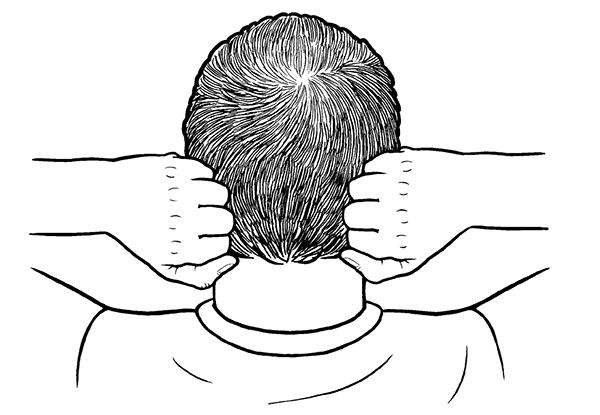 Figure 9.1 (Pituitary and Hypothalamus Tap)
Figure 9.1 (Pituitary and Hypothalamus Tap)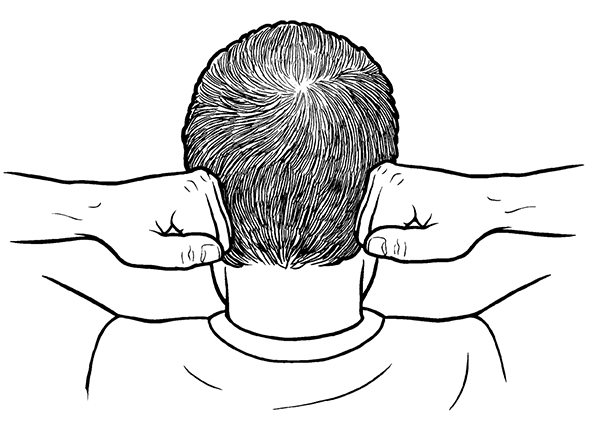 Figure 9.2 (Pituitary and Hypothalamus Tap)
Figure 9.2 (Pituitary and Hypothalamus Tap)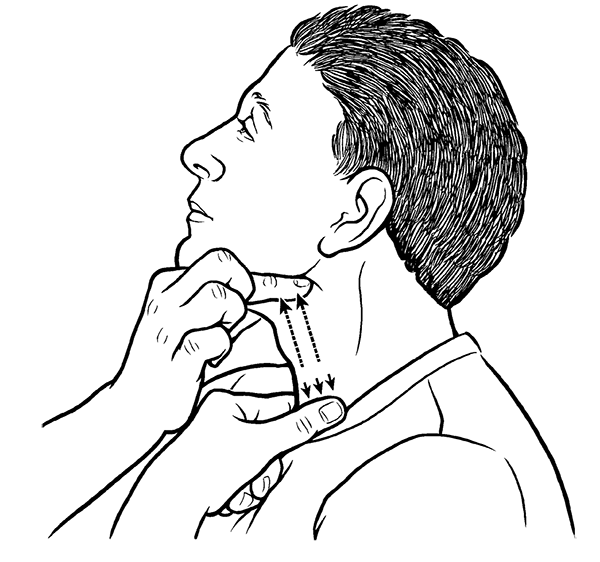 Figure 9.3 (Thyroid Massage)
Figure 9.3 (Thyroid Massage)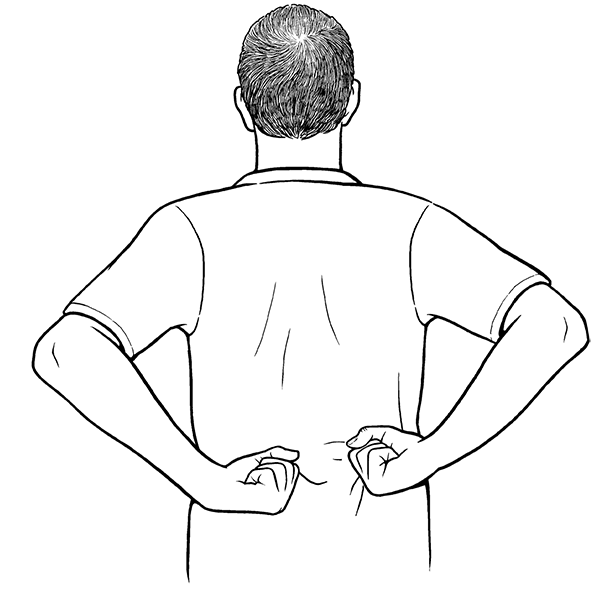 Figure 9.4 (Kidney/Adrenal Tap)
Figure 9.4 (Kidney/Adrenal Tap)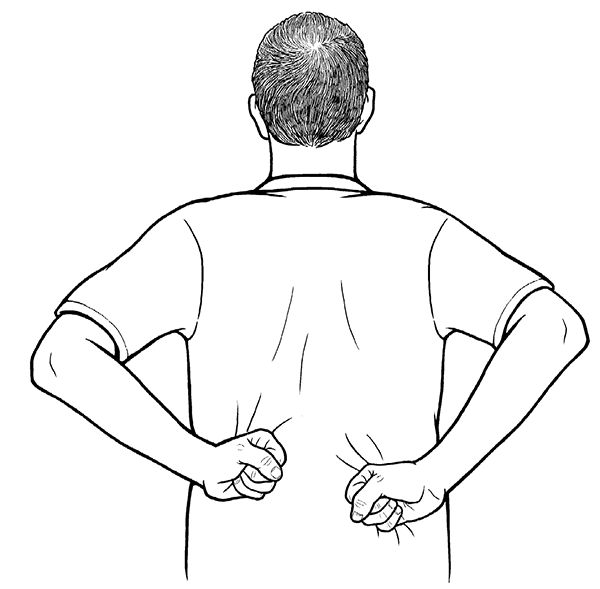 Figure 9.5 (Kidney/Adrenal Tap)
Figure 9.5 (Kidney/Adrenal Tap)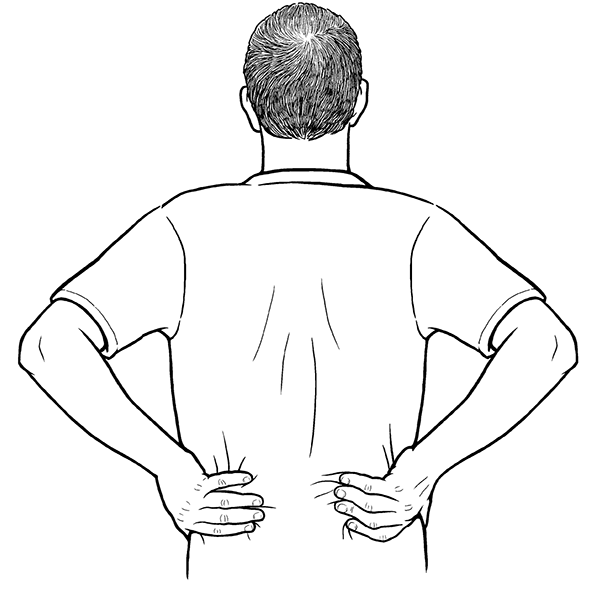 Figure 9.6 (Kidney Massage)
Figure 9.6 (Kidney Massage)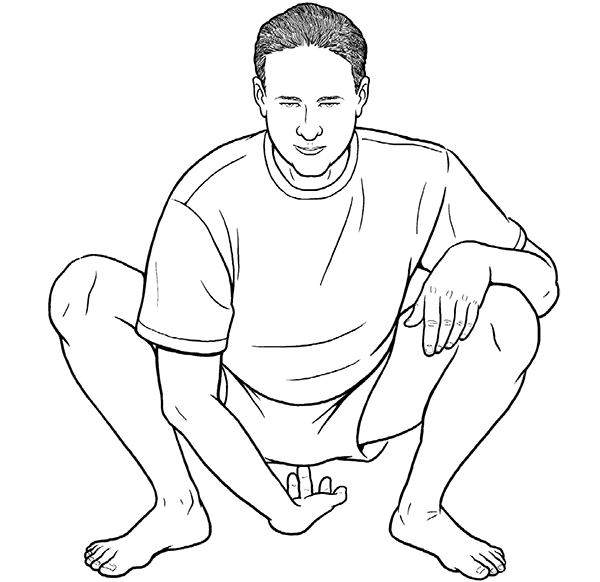 Figure 9.7 (For Men Only—Prostate Massage)
Figure 9.7 (For Men Only—Prostate Massage)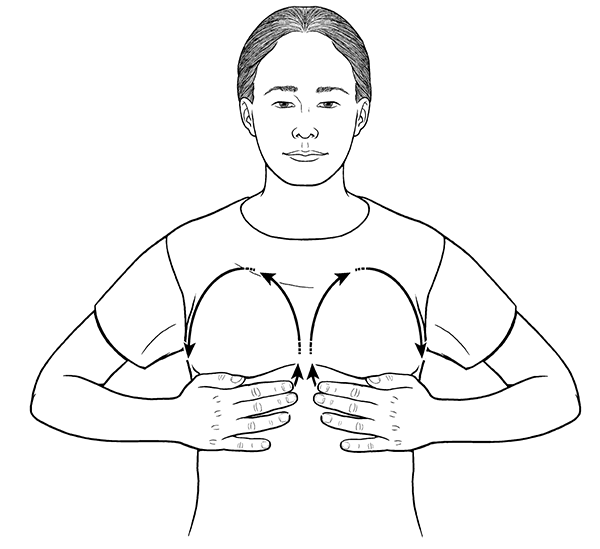 Figure 9.8A (For Women Only—Breast Massage)
Figure 9.8A (For Women Only—Breast Massage)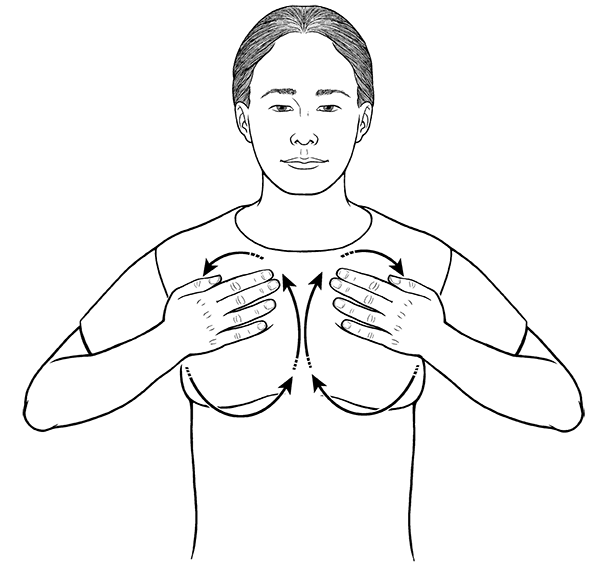 Figure 9.8B (For Women Only—Breast Massage)
Figure 9.8B (For Women Only—Breast Massage)